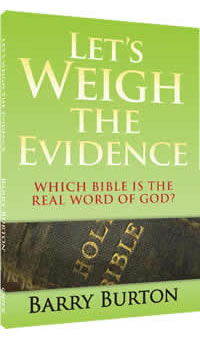Where Did the King James Bible Come From?
Adapted from LET'S WEIGH THE EVIDENCE by Barry Burton. Concerned that the whole issue of "Which Bible?" was confusing members of his church, Burton wrote this easy-to-read summary of the research of many gifted men in the field of Bible translation. Here is just a small portion of this very readable book.
There Are Two Kinds of Manuscripts:
Accurate Copies
These manuscripts represent the manuscripts from which the "Textus Receptus" or Received Text was taken.
They are the majority of Greek manuscripts which agree with each other and have been accepted by Bible believing Christians down through the centuries. It is from these manuscripts that the King James Bible was translated in 1611.
Corrupted Copies
These manuscripts represent the corrupted copies of the Bible, also known as the Alexandrian manuscripts. These manuscripts, many times, do not even agree with each other. The Vaticanus and Sinaiticus manuscripts are part of this group. These are the manuscripts on which Westcott and Hort and the modern versions rely so heavily.
There are 5,309 surviving Greek manuscripts that contain all or part of the New Testament. These manuscripts agree together 95% of the time. The other 5% account for the differences between the King James and the modern versions.
The modern versions had to use the Textus Receptus, since it contains the majority of the surviving Greek manuscripts. The problem is that, when the Textus Receptus disagreed with the Vaticanus or the Sinaiticus, they preferred these corrupted manuscripts over the Textus Receptus.
That accounts for the 5% corruption in the modern versions. Even these two manuscripts agree with the Textus Receptus much of the time. When they do not agree, it is because Marcion (120-160 AD) or Origin (184-254 AD) or whoever, corrupted them.
Now, the fact has been established that the modern versions are different than the King James Bible (see LET'S WEIGH THE EVIDENCE for numerous, verse by verse examples). But, we still need to answer the question: Why are they different?
There are at least 5,309 surviving Greek manuscripts which contain all or part of the New Testament. Plus, there are translations into different languages which date back to within 100 years of the disciples. For example, the Peshitta is a Syrian translation from the 2nd century.
These manuscripts agree with each other about 95% of the time. The problem is, how does one determine what is right in the 5% of the places where the manuscripts do not agree?
Argument One
(Modern versions) "The Bible is just like any other book. It is not liable to Satanic attack. In order to find out what the original copy probably said, you just find the oldest copies available and use them.
"We don't have the exact word of God now anyway, so a few disagreements will not matter."
Argument Two
(King James Bible) "The Bible is not 'just like any other book.' Satan hates it because it is the Word of God. Satan has been trying to destroy it ever since the Garden of Eden.
"However, God has preserved His Word for us. He preserved the Old Testament through the Levites as priests and He has preserved the New Testament through the body of believers through the witness of the Holy Spirit."
The vast majority of Greek manuscripts agree together. They have been passed down through the centuries by true Bible-believing Christians.
In 1516 Erasmus compiled, edited, and printed the Greek "Textus Receptus" (received text). This is the text that the Protestants of the Reformation knew to be the Word of God (inerrant and infallible). The King James Bible was translated from the "Textus Receptus."
The debate continues:
Argument One
(Modern versions) The oldest surviving manuscripts must be the most reliable. Therefore, when determining what manuscripts to depend on, the Vaticanus (350 AD) and the Sinaiticus (about 350 AD) should be accepted as correct (even if 998 other manuscripts disagree with them).
Argument Two
(King James) The oldest manuscripts (the Vaticanus and Sinaiticus) are not reliable at all! But wait, the Vaticanus and Sinaiticus disagree with each other over 3,000 times in the gospels alone!
Facts About the Vaticanus
It was written on fine vellum (tanned animal skins) and remains in excellent condition. It was found in the Vatican Library in 1481 AD. In spite of being in excellent condition, it omits:
Genesis 1:1 through Genesis 46:28
Psalms 106-138
Matthew 16:2-3
The Pauline Pastoral Epistles
Hebrews 9:14-13:25
Revelation
These parts were probably left out on purpose.
Besides all that, in the gospels alone it leaves out 237 words, 452 clauses and 748 whole sentences, which hundreds of later copies agree together as having the same words in the same places, the same clauses in the same places and the same sentences in the same places.
The Vaticanus was available to the translators of the King James Bible, but they didn't use it because they knew it is unreliable. The Vaticanus also contains the Apocrypha.
Facts About the Sinaiticus
The Sinaiticus is a manuscript that was found in 1844 in a trash pile in St. Catherine's Monastery near Mt. Sinai, by a man named Mr. Tischendorf. It contains nearly all of the New Testament plus it adds the "Shepherd of Hermes" and the "Epistle of Barnabas" to the New Testament.
The Sinaiticus is extremely unreliable, proven by examining the manuscript itself. John Burgeon spent years examining every available manuscript of the New Testament. He writes about the Sinaiticus:
"On many occasions 10, 20, 30, 40 words are dropped through very carelessness.
Letters, words or even whole sentences are frequently written twice over, or begun and immediately canceled; while that gross blunder, whereby a clause is omitted because it happens to end in the same words as the clause preceding, occurs no less that 115 times in the New Testament."
That's not all!
On nearly every page of the manuscript there are corrections and revisions, done by 10 different people. Some of these corrections were made about the same time that it was copied, but most of them were made in the 6th or 7th century.
Phillip Mauro was a brilliant lawyer who was admitted to the bar of the Supreme Court in April 1892. He wrote a book called "Which Version" in the early 1900's. He writes concerning the Sinaiticus:
"From these facts, therefore, we deduce: first that the impurity of the Codex Sinaiticus, in every part of it, was fully recognized by those who were best acquainted with it, and that from the very beginning until the time when it was finally cast aside as worthless for any practical purpose."
The Vaticanus and Sinaiticus manuscripts are the oldest, but they are not the best manuscripts!!!
That's where the modern translators went wrong! They foolishly accepted the Vaticanus and Sinaiticus simply because they were old.
They did not attempt to find out why they were so vastly different from the Greek text that real Christians have known to be the infallible Word of God.
When the modern versions say in the footnotes, "Some of the oldest mss. do not contain vv. 9-20," or "This verse not found in the most ancient authorities," they are taking their information from the corrupt and unreliable Vaticanus and Sinaiticus manuscripts!
Don't fall for the "oldest are the best" line! The oldest are not the best! For example, the Vaticanus and Sinaiticus both leave out the last 12 verses of Mark, concerning the resurrection of Christ.
But, there is not one other manuscript, either uncial or cursive, that leave out this passage. There are 18 other uncial (capital letter) manuscripts that have the passage in and at least 600 cursives (small letter) manuscripts that all contain these verses.
The evidence is at least 618 to 2 against the Vaticanus and Sinaiticus. Yet, look in your modern version.
The New American Standard Bible puts all these verses (Mark 16:9-20) in brackets, saying that these verses probably were not in the original writings. The other versions use brackets or footnotes.
That's ridiculous!!! In a court of law, if you had 618 witnesses that saw something happen, and you had two witnesses that said they did not see it happen, would you accept the testimony of the 618 or the testimony of the 2?
You see, it is foolish for any translator to accept a manuscript simply because of age, without checking to find out where it came from and if it was reliable or not.
Why do the modern versions question the virgin birth of Christ, attack the doctrine of the deity of Christ, the infallibility of the Bible, the doctrine of salvation by faith and the Trinity?
For the surprising answer to this and many other questions, read LET'S WEIGH THE EVIDENCE by Barry Burton. (Space does not permit including here all the vital information found in this book!)
- See more articles on related topics:
- Bible Versions
- King James Bible
- Ten Commandments
- Codex Sinaiticus
- Two Types of Bible Versions
- History of Preservation
Other Articles from September/October 1993:
More on Bible Versions:
Products of Interest:
-

Let's Weigh the Evidence
96 pages
In simple language, this book provides the basics of the Bible version issue, showing why the King James is the only Bible you can trust. Compare the solid history of the King James Bible with the new Bibles that remove Christ’s Virgin Birth and His Second Coming. Learn about Westcott and Hort’s bait-and-switch, missing verses and words, the Living Bible’s tampering, copyright issues, and more! -

Is The "World's Oldest Bible" a Fake?
352 pages
Here is proof that the Sinaiticus, a supposedly ancient Bible text on which modern Bibles are based, is actually a 19th-century fake. -

Answers to Your Bible Version Questions
224 pages
David W. Daniels answers difficult questions about the KJV. Learn how to defend the KJV and why you can trust it. -

Understandable History of the Bible
557 pages
You'll learn the history of the Bible in this well-documented but easy-to-understand book.



